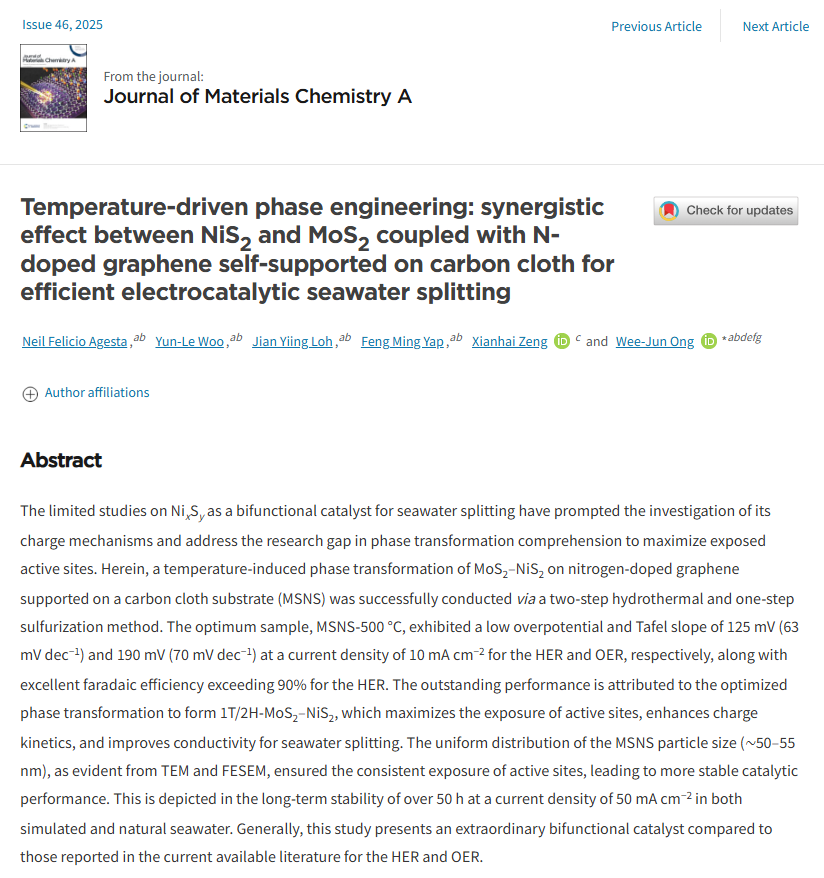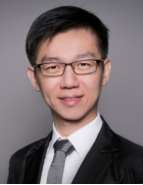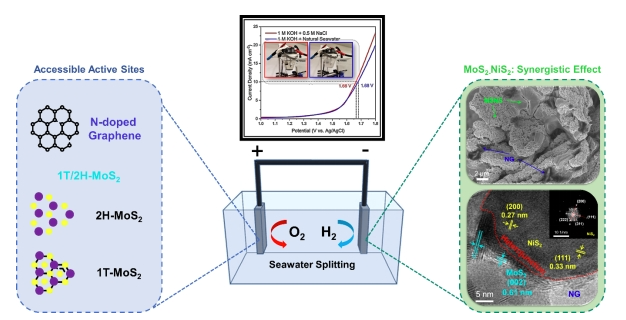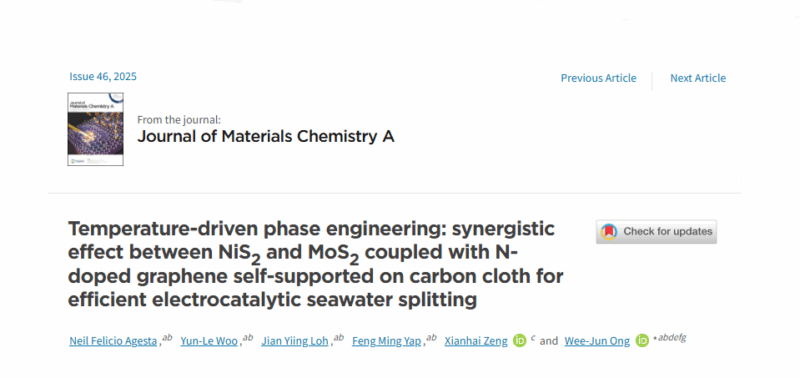The Research and Postgraduate Centre congratulates postgraduate and undergraduate students Neil Felicio Agesta, Woo Yun-Le, Loh Jian Yiing, Yap Feng Ming, and Prof. Dr. Ong Wee Jun from the School of Energy and Chemical Engineering and the Center of Excellence for NaNo Energy & Catalysis Technology (CONNECT) on their recent publication in Journal of Materials Chemistry A, a peer-reviewed SCI Q1 journal published Royal Society of Chemistry (RSC), with a current impact factor of 9.5. According to Clarivate (Web of Science), the journal ranks top 14% in the multidisciplinary materials science category.
The research article, titled “Temperature Driven Phase Engineering: Synergistic Between NiS2 and MoS2 Coupled with N-Doped Graphene Self-supported on Carbon Cloth for Efficient Electrocatalytic Seawater Splitting“, presents a method to engineer a NiS2-MoS2 (MSNS) electrocatalyst for overall seawater splitting, encapsulating hydrogen generation (HER) and oxygen evolution (OER) under ambient conditions, contributing to clean and renewable fuel production.
The article is first-authored by Master’s student Neil Felicio Agesta and co-authored by undergraduate student Woo Yun-Le and PhD candidates Loh Jian Yiing and Yap Feng Ming, under the supervision of Prof. Dr. Ong. The research also includes collaborative contributions from Prof. Dr. Zeng Xianhai of Xiamen University, China.
This study investigates a temperature-induced phase transformation to synthesize MoS2-NiS2 on a nitrogen-doped graphene substrate (MSNS), resulting in a bifunctional catalyst for seawater splitting. The optimized catalyst, MSNS-500 °C, maximizes the exposure of active sites through the formation of a 1T/2H-MoS2-NiS2 heterostructure, which enhances charge kinetics and improves electrical conductivity. The material exhibited low overpotentials and high Faradaic efficiency for both the hydrogen and oxygen evolution reactions (HER/OER), along with exceptional long-term stability, exceeding 50 hours in both simulated and natural seawater. This work offers a novel approach to designing durable, high-performance, and cost-effective electrocatalysts for sustainable hydrogen production from seawater resources.
This research project received funding support from the Ministry of Higher Education Malaysia under the Fundamental Research Grant Scheme (FRGS); PETRONAS Research Sdn. Bhd. (PSRB) through the PETRONAS-Academia Collaboration Dialogue; the Ministry of Science, Technology and Innovation (MOSTI) Malaysia under the Strategic Research Fund (SRF); the National Natural Science Foundation of China; Guangdong Basic and Applied Basic Research Foundation; the State Key Laboratory of Physical Chemistry of Solid Surfaces, Xiamen University; and the Embassy of the People’s Republic of China in Malaysia. Additional support was provided by the Xiamen University Malaysia Investigatorship Grant and the Xiamen University Malaysia Research Fund.

The published full article can be accessed at: https://doi.org/10.1039/D5TA01054C
 | Neil Felicio Agesta received his Bachelor of Chemical Engineering with Honors from Xiamen University, Malaysia in 2024 and is a Master's student in New Energy Science and Engineering, specializing in nanotechnology and energy generation technologies through advanced material science. His research focuses on harnessing plasma technology and developing efficient electrocatalysts to innovate real-world applications in clean energy. |
 | Wee-Jun Ong received his BEng and PhD in chemical engineering from Monash University. He is a Professor in the School of Energy and Chemical Engineering at Xiamen University Malaysia. Starting from 2021, he became the director of CONNECT research center. His research interests include nanomaterials for photo(electro)catalytic and electrochemical H2O splitting, CO2 reduction, H2O2 synthesis, N2 fixation, alcohol oxidation and organic synthesis as well as microwave plasma methane cracking for graphene and hydrogen production. He has received many prestigious awards, including 2019-2024 Global Highly Cited Researcher (Clarivate Analytics), 2020-2024 World's Top 2% Scientists by Stanford University, 2024 Malaysia Scopus Research Excellence Award and many more. For more details, refer to his website: https://sites.google.com/site/wjongresearch/ |

Graphical abstract of the work published in Journal of Materials Chemistry A.
